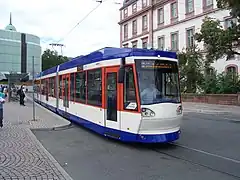| Darmstadt tramway network | |||||||||||||||||||||||||
|---|---|---|---|---|---|---|---|---|---|---|---|---|---|---|---|---|---|---|---|---|---|---|---|---|---|
 Tram at Willy-Brandt-Platz | |||||||||||||||||||||||||
| Operation | |||||||||||||||||||||||||
| Locale | Darmstadt, Hesse, Germany | ||||||||||||||||||||||||
| |||||||||||||||||||||||||
| |||||||||||||||||||||||||
The Darmstadt tram network is a light rail system and the backbone of public transport within Darmstadt, a city in the federal state of Hesse, Germany. As of 2014, nine lines on four main routes (42 kilometres (26 mi)) serve 162 stops, including 92 low-floor stops.[1] The system is operated by HEAG mobilo, and is an integral part of the Rhein-Main-Verkehrsverbund (RMV), the public transit authority of the Rhein-Main-Area.
History
Trams have operated continuously in Darmstadt since 1886, with the opening of a steam tram line. The network has been operated since 1912 by Hessische Eisenbahn-Aktiengesellschaft (HEAG) either directly, or, more recently, through one of its subsidiaries. Since then the trams have become a distinctive part of Darmstadt's character and are widely used by people from all walks of life as a safe and fast means of transportation within Darmstadt and its suburbs. At the Hauptbahnhof station (HBF) the tram system and the Rhine-Main S-Bahn meet. While some older lines like the Oberwaldhaus-/Martinsviertel-/and Ostbahnhof lines were closed, new sections were built, following the development of new residential areas, e.g. the new lines to Kranichstein, Arheilgen north and Alsbach south. Since the 1990s the tram system has gradually been modernised. All lines (except for line 3) have since been less of a classical tram system and more of a light rail system (Stadtbahn) with a private right-of-way and separate stations with "same-level-platforms".
Lines
The central hub of the Darmstadt tram network is the "Luisenplatz", at which eight of Darmstadt's nine tram lines stop. On the main routes the hours of operation are usually from around 5:00 am until 1:00 am. The network is currently made up of the following lines:
| Line | Route | Monday–Friday | Monday–Friday (peak times) | Saturday | Sunday | Late evening and Sunday morning | Notes | ||
|---|---|---|---|---|---|---|---|---|---|
| 1 | Hauptbahnhof | ↔ Rhein-/Neckarstr. ↔ | Eberstadt | 30 Min | 30 Min | – | – | – | |
| 2 | Hauptbahnhof | ↔ Luisenplatz ↔ | Böllenfalltor | – | 15 Min | – | – | – | only at peak times on school days |
| 3 | Hauptbahnhof | ↔ Willy-Brandt-Platz ↔ Luisenplatz ↔ | Lichtenbergschule | 15 Min | 10 Min | 15 Min | 15 Min | 30 Min | at peak times on school days, at 10 min. intervals |
| 4 | Griesheim | ↔ Luisenplatz ↔ | Kranichstein | – | 15 Min | – | – | – | only at peak times on school days |
| 5 | Hauptbahnhof | ↔ Luisenplatz ↔ | Kranichstein | 15 Min | 15 Min | 15 Min | 15 Min | 30 Min | at peak times, when line 4 is not operating: 7/8 min. intervals |
| 6 | Arheilgen | ↔ Merck ↔ Luisenplatz ↔ Eberstadt ↔ | Alsbach | 15 Min | 15 Min | – | – | – | „Schnelle 6“, Mo-Fr, 5–19 Hours (express line, does not stop at all stations) |
| 7 | Arheilgen | ↔ Merck ↔ Luisenplatz ↔ | Eberstadt | 15 Min | 15 Min | 30 Min | 30 Min | – | runs at 30 min. intervals, when line 8 is running |
| 8 | Arheilgen | ↔ Merck ↔ Luisenplatz ↔ Eberstadt ↔ | Alsbach | 15 min | – | 30 min | 30 min | 30 min | runs only when line 6 is not running |
| 9 | Griesheim | ↔ Luisenplatz ↔ | Böllenfalltor | 15 Min | 15 Min | 15 Min | 15 Min | 30 Min | at peak times, when line 2 is not operating: 7/8 min. intervals |
All lines run – unless otherwise stated – at 15-minute intervals (at night and on Sunday mornings at 30-minute intervals). On the southern route between Eberstadt and Alsbach, service intervals are 15 minutes during peak hours and 30 minutes in the evenings. Since many stations are being served by more than one line, service intervals are 3 to 7 minutes at the central stations, especially in the city centre.
Rolling stock
The fleet consists of 48 trams and 30 trailers.[2] 14 new Stadler-built low-floor trams are scheduled to enter service in 2022.[2] A follow-on order for a further 11 trams was announced in June 2021. The five-section unidirectional Stadler ST15 trams are due to enter service between mid-2023 and mid-2024, allowing the ST12 vehicles to be withdrawn.[3]
 High-floor ST12 tram
High-floor ST12 tram SB9 trailer
SB9 trailer ST14 tram
ST14 tram ST14 interior
ST14 interior![Stadler Tina [de] ST15 tram](../I/Stra%C3%9Fenbahn-ST15-22103-Darmstadt-Jan2023.jpg.webp) Stadler Tina ST15 tram
Stadler Tina ST15 tram
See also
Bibliography
- Bürnheim, Hermann; Burmeister, Jürgen (1997). Bahnen und Busse rund um den langen Ludwig. (Engl.: Railways and Buses around the long Ludwig) (4th ed.). Düsseldorf: Alba Publikation. ISBN 3-87094-357-2. (German)
- Höltge, Dieter; Köhler, Günter H. (1992). Straßen- und Stadtbahnen in Deutschland [Tramways and Stadtbahnen in Germany] (in German). Vol. Band 1: Hessen [Volume 1: Hesse] (2nd., enlarged ed.). Freiburg i. B., Germany: EK-Verlag. ISBN 3882553359.
- Schwandl, Robert (2012). Schwandl's Tram Atlas Deutschland (3rd ed.). Berlin: Robert Schwandl Verlag. ISBN 978-3-936573-33-6.
References
- 1 2 HEAG Facts and Figures 2012 Retrieved 23 October 2014
- 1 2 "Stadler liefert neue Straßenbahngeneration an HEAG mobilo Darmstadt" [Stadler supplies new generation of tram to HEAG mobilo Darmstadt]. Urban Transport Magazine (in German). 6 January 2020. Archived from the original on 29 February 2020. Retrieved 29 February 2020.
- ↑ "HEAG Mobilo orders more trams". Railway Gazette International. 7 July 2021. Retrieved 13 January 2023.
External links
- HEAG mobilo – official website
- Darmstadt database / photo gallery and Darmstadt tram list at Urban Electric Transit – in various languages, including English.
- Darmstadt database / photo gallery at Phototrans – in various languages, including English.


